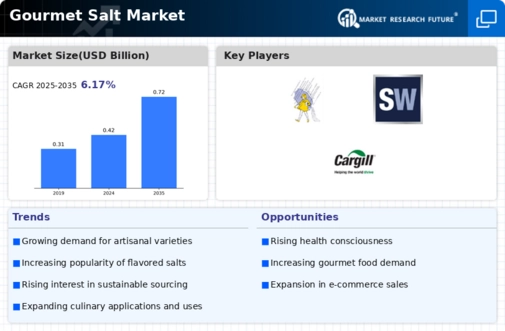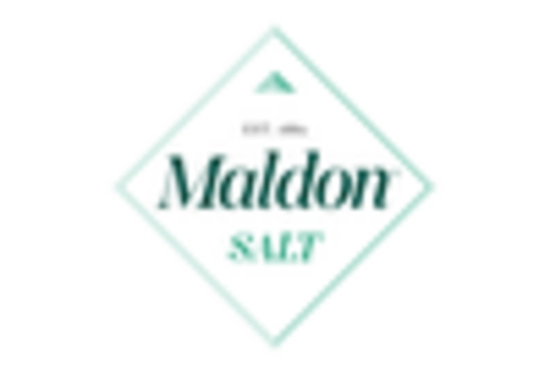Artisanal Production Methods
The Gourmet Salt Market is increasingly influenced by the rise of artisanal production methods. Consumers are gravitating towards products that are crafted with care and attention to detail, often sourced from specific regions known for their unique salt varieties. This artisanal approach not only enhances the perceived quality of the product but also appeals to consumers' desire for authenticity and transparency in their food choices. The market for artisanal gourmet salts has expanded, with many producers emphasizing traditional harvesting techniques and sustainable practices. This trend is reflected in the increasing number of small-scale producers entering the market, contributing to a diverse range of flavors and textures. As consumers continue to seek out unique culinary experiences, the artisanal production of gourmet salts is likely to play a pivotal role in shaping the future of the Gourmet Salt Market.
Health Conscious Consumer Trends
The Gourmet Salt Market is experiencing a notable shift as consumers increasingly prioritize health and wellness. This trend is driven by a growing awareness of the impact of dietary choices on overall health. Gourmet salts, often perceived as healthier alternatives to regular table salt, are gaining traction among health-conscious individuals. According to recent data, the demand for natural and organic food products has surged, with gourmet salts being a key component of this movement. Consumers are seeking products that not only enhance flavor but also offer potential health benefits, such as lower sodium content or mineral richness. This shift is likely to propel the growth of the Gourmet Salt Market, as brands adapt their offerings to meet the evolving preferences of health-oriented consumers.
E-commerce and Online Retail Growth
The Gourmet Salt Market is experiencing a transformation driven by the growth of e-commerce and online retail platforms. As consumers increasingly turn to online shopping for convenience and variety, gourmet salts are becoming more accessible than ever. This shift is supported by data indicating a significant rise in online food sales, with gourmet products being a key category. E-commerce platforms allow consumers to explore a wider range of gourmet salt options, including niche and artisanal brands that may not be available in traditional retail settings. This trend is likely to enhance market competition and drive innovation, as brands seek to establish a strong online presence. The ongoing expansion of e-commerce is expected to play a crucial role in shaping the future landscape of the Gourmet Salt Market, providing opportunities for growth and increased consumer engagement.
Sustainability and Ethical Sourcing
The Gourmet Salt Market is increasingly shaped by consumer demand for sustainability and ethical sourcing practices. As awareness of environmental issues grows, consumers are more inclined to support brands that prioritize eco-friendly production methods and responsible sourcing. Gourmet salts sourced from sustainable environments, such as sea salts harvested through traditional methods, are gaining popularity. This trend is reflected in the increasing number of certifications and labels that emphasize sustainable practices. Market Research Future suggests that consumers are willing to pay a premium for products that align with their values, indicating a potential growth opportunity for brands that adopt sustainable practices. As the Gourmet Salt Market evolves, the emphasis on sustainability is likely to become a defining characteristic, influencing purchasing decisions and brand loyalty.
Culinary Innovation and Experimentation
The Gourmet Salt Market is witnessing a surge in culinary innovation, as chefs and home cooks alike experiment with diverse flavor profiles. This trend is fueled by a growing interest in gourmet cooking and the desire to elevate everyday meals. Gourmet salts infused with various herbs, spices, and even exotic ingredients are becoming increasingly popular, allowing consumers to explore new taste experiences. Market data indicates that the segment of flavored gourmet salts is expanding rapidly, with consumers eager to incorporate these unique products into their cooking. This innovation not only enhances the culinary landscape but also drives the demand for gourmet salts, as individuals seek to differentiate their dishes and impress guests. The ongoing experimentation in the kitchen is likely to sustain the momentum of the Gourmet Salt Market, as new flavors and combinations continue to emerge.


















Leave a Comment